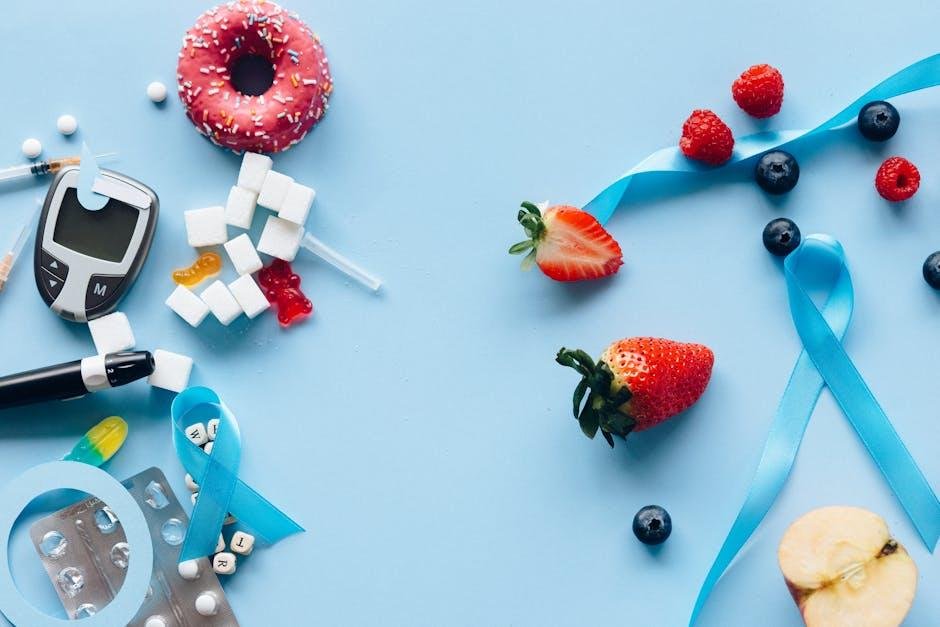Maintaining balanced blood sugar levels is essential for overall health and well-being. Whether you’re managing diabetes, prediabetes, or simply aiming to improve your energy and mood, making smart diet choices can play a significant role. In this article, we’ll explore practical and effective ways to keep your blood sugar stable through thoughtful nutrition. From understanding which foods to prioritize to tips on meal timing and portion control, you’ll find helpful guidance to support your journey toward better health.
Table of Contents
- Understanding the Role of Carbohydrates in Blood Sugar Management
- Incorporating Fiber-Rich Foods to Stabilize Glucose Levels
- Choosing Healthy Fats and Proteins for Balanced Energy
- Practical Meal Planning Tips for Maintaining Consistent Blood Sugar
- To Wrap It Up
Understanding the Role of Carbohydrates in Blood Sugar Management
Carbohydrates are a primary energy source for the body, but their impact on blood sugar levels can vary widely depending on the type and amount consumed. When carbohydrates enter the digestive system, they break down into glucose, which then enters the bloodstream. This increase in blood sugar triggers insulin release, a hormone essential for helping cells absorb glucose for energy. However, not all carbohydrates affect blood sugar equally. Simple carbs, such as those found in sugary snacks and white bread, tend to cause rapid spikes and crashes in glucose levels. In contrast, complex carbs like whole grains, legumes, and vegetables digest more slowly, providing a steadier source of energy and preventing sudden blood sugar surges.
Understanding the glycemic index (GI) is a valuable tool for managing blood sugar through diet. Foods with a low GI score are absorbed more gradually, helping maintain balanced glucose levels. To optimize blood sugar management, consider incorporating the following strategies into your meals:
- Choose whole fruits over fruit juices to benefit from fiber content
- Combine carbohydrates with protein or healthy fats to slow digestion
- Limit intake of refined sugars and processed foods
- Focus on portion control and meal timing to avoid overload
Incorporating Fiber-Rich Foods to Stabilize Glucose Levels
Fiber plays a crucial role in managing blood glucose levels because it slows the absorption of sugar into the bloodstream, preventing sudden spikes. Incorporating a variety of fiber-rich foods into your daily meals can create a more gradual energy release, which supports better insulin response and keeps cravings at bay. Foods high in soluble fiber, such as oats, barley, and legumes, form a gel-like substance in the gut that helps regulate digestion and glucose uptake. Meanwhile, insoluble fiber found in whole grains and vegetables adds bulk to the diet, promoting digestive health and steady blood sugar control.
To maximize the benefits of fiber, consider adding these nutrient-dense options to your shopping list:
- Chia seeds and flaxseeds: Rich in both soluble fiber and omega-3 fatty acids.
- Beans and lentils: Excellent sources of sustained-release carbohydrates.
- Fresh fruits like apples, pears, and berries: Packed with fiber and antioxidants.
- Vegetables such as broccoli, Brussels sprouts, and carrots: Provide generous amounts of insoluble fiber.
Including these foods regularly can help foster glucose stability and support overall metabolic health, creating a foundation for balanced blood sugar throughout the day.
Choosing Healthy Fats and Proteins for Balanced Energy
When focusing on maintaining stable blood sugar levels, the types of fats and proteins you incorporate into your diet play a pivotal role. Opting for unsaturated fats such as those found in avocados, nuts, seeds, and olive oil provides long-lasting energy without causing sudden blood sugar spikes. These healthy fats help slow digestion and insulin response, leading to a more controlled release of glucose into the bloodstream. Additionally, incorporating lean protein sources like chicken, turkey, tofu, and fish can further support sustained energy by promoting fullness and reducing cravings for high-sugar snacks.
To build balanced meals that fuel your body efficiently, consider mixing these nutrient-dense options:
- Avocado slices atop a leafy green salad drizzled with extra virgin olive oil
- Grilled salmon paired with steamed vegetables and quinoa
- Chickpea and spinach stir-fry seasoned with turmeric and cumin
- Greek yogurt mixed with chia seeds and a handful of walnuts
By thoughtfully combining these fats and proteins, you encourage a steady flow of energy throughout the day while mitigating risky blood sugar fluctuations.
Practical Meal Planning Tips for Maintaining Consistent Blood Sugar
Creating a balanced plate starts with understanding the impact of each food group on blood sugar. Focus on incorporating a variety of fiber-rich vegetables, legumes, and whole grains to slow down glucose absorption and keep energy levels steady throughout the day. Pair complex carbs with lean proteins and healthy fats to enhance satiety and further stabilize blood sugar. Portion control is equally important; using smaller plates or measuring servings can prevent unintentional overeating, which can spike blood sugar levels.
Consistency is key, so try to eat meals and snacks at regular intervals to avoid dramatic highs and lows. Consider prepping meals ahead of time to reduce the temptation of quick, high-sugar options. Here are some practical strategies to implement:
- Batch cook and freeze portion-controlled meals for busy days.
- Include a source of protein or healthy fat with every meal to slow digestion.
- Limit processed sugars and refined carbs which can cause rapid blood sugar spikes.
- Stay hydrated as even mild dehydration can affect blood glucose balance.
To Wrap It Up
Maintaining balanced blood sugar levels doesn’t have to be complicated. By making smart, consistent diet choices—like prioritizing whole foods, balancing carbs with fiber and protein, and staying mindful of portion sizes—you can support your body’s natural rhythms and overall health. Remember, small changes add up over time, so be patient with yourself and focus on sustainable habits. If you’re ever unsure about what’s best for your individual needs, consulting a healthcare professional or registered dietitian can provide personalized guidance. Here’s to making mindful choices that help keep your blood sugar—and your well-being—in check!



![Patriotic Unisex Tee – Land of the Free – Brave American Heroes Shirt, Memorial Day Gift, Veteran’s Day Tee, Independence Day Style, […] Patriotic Unisex Tee – Land of the Free – Brave American Heroes Shirt, Memorial Day Gift, Veteran’s Day Tee, Independence Day Style, […]](https://rootedmomlife.com/wp-content/uploads/2025/06/3793916843542155919_2048-300x300.jpeg)



